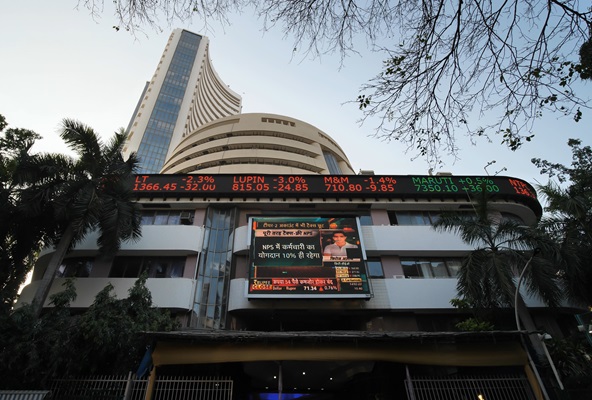.png)

Chokkalingam, Founder of Equinomics Research, has over 40 years of experience in economics and markets, leading research teams at top financial firms.
April 20, 2025 at 2:57 PM IST
The Indian stock market’s recent volatility has been a harsh reminder of how quickly wealth can erode, especially for those heavily invested in small and mid-cap stocks. Between September 2024 and February 2025, the total market capitalisation of listed stocks plunged by over ₹100 trillion, wiping out more value than the entire market was worth just a decade ago. This loss equalled nearly 30% of India’s nominal GDP for the year, and the brunt of the damage was felt in the SMC segment. Notably, this period also witnessed a record influx of new investors, many of whom were drawn to the promise of quick gains in smaller stocks - only to find themselves caught in a sharp downturn.
Learn From History
A closer look at market history reveals that such episodes are not new. Over the past 25 years, SMC stocks have crashed multiple times, often triggered by external shocks like drought, global financial crises, or pandemics, but just as frequently by their own overvaluation. The 2018–19 period stands out as a recent example, when SMC stocks tumbled much more than their large-cap counterparts due to inflated valuations. Even though the market has recovered a third of its losses since March 2025, and some SMC stocks have started to rally, it’s important to remember that not all stocks rebound after a crash. For many, the destruction of wealth is permanent.
One of the most common traps investors fall into is chasing hot themes without regard for the underlying quality or valuation of the stocks involved. The 1990s aquaculture boom, for instance, saw a flurry of new listings and soaring prices, but today, only one company from that wave remains in the market. The rest vanished, taking investors’ money with them. The lesson here is clear. Before getting swept up in thematic trends, investors must evaluate both the quality of the company and whether the stock’s price is justified by its fundamentals.
The risk is even higher in the small- and mid-cap segment, where hundreds of stocks have disappeared from the market over the years, often delisted due to compliance failures. Nearly all of these were small caps at the time of suspension. For most retail investors, especially those without professional expertise or a high risk appetite, concentrating all their equity allocation in SMC stocks is a recipe for trouble.
Allocating a significant portfolio at least 30 to 40% - of one’s equity portfolio to large, stable stocks such as those in the Sensex or Nifty 50 can help cushion against market shocks. Diversification is equally important: spreading investments across at least 15 to 20 stocks from five or six different sectors can minimise the risk of any single blowup derailing an entire portfolio.
Selecting individual small- and mid-cap stocks requires discipline and a methodical approach, as even seasoned professionals have made costly mistakes in this space. The first step is to scrutinise the shareholding pattern. If a stock with a market cap above ₹30 billion or ₹40 billion has little or no institutional ownership, it’s a warning sign. Institutional investors, such as mutual funds and insurance companies, conduct rigorous due diligence before investing; their absence should prompt a deeper investigation.
Portfolio Building
A long track record in the secondary market—ideally a decade or more—makes it easier to judge a company’s management and governance. Frequent changes in company names or business focus to align with market fads should also raise red flags. Some firms claim to be part of a hot theme but are primarily engaged in trading activities, which can be verified by examining their balance sheets. For technology companies, a genuine commitment to their stated business should be evident in their expenses; if less than five percent of total expenses go toward employees, it’s worth questioning the legitimacy of their tech credentials.
Debt levels are another crucial factor. Companies with no debt are preferable, but if that’s not possible, a debt-to-equity ratio around one is a reasonable upper limit. The debt-to-sales ratio is equally telling: if debt exceeds annual sales, the company must generate high operating margins just to service its loans—a situation that has led many firms into distress and, ultimately, delisting.
Working capital management deserves attention as well. Unless a company operates in a seasonal industry, inventories plus receivables should not exceed about a third of annual sales. Excessive inventory can indicate unsold, obsolete, or rejected goods, which often precede a decline in business fortunes.
Finally, valuation comfort is essential. Many new-age or thematic stocks that suffered the worst losses in the recent meltdown were trading at price-to-earnings ratios of 50 to 100 times, far outpacing their profit growth. A practical rule of thumb is that if a stock trades at 80 times earnings, its net profit should be growing at least 40 percent year-on-year. Ideally, the PE ratio should align with profit growth, though some flexibility is needed to avoid missing out on opportunities. Looking back, applying these valuation filters would have helped investors sidestep much of the recent wealth destruction in SMC stocks.
In summary, avoiding wealth erosion in the markets is less about chasing the next big thing and more about sticking to the basics: diversify across sectors and market caps, scrutinise quality and management, keep an eye on debt and working capital, and never lose sight of valuation. The cycles of boom and bust will continue, but investors who follow these principles will be better positioned to preserve and grow their wealth over time.




